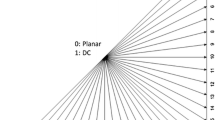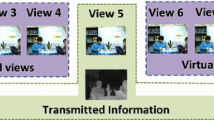Abstract
The emerging of 3D video-capable embedded mobile devices is expected due to the popularization of multimedia services and the demand for novel immersive video technologies. Such devices require efficient hardware-friendly heuristics to deal with strict processing requirements and limited energy supply. To contribute to these requirements, this work presents a complete 3D-HEVC intra-frame prediction hardware design that supports a flexible coding order between texture and depth channels. The developed hardware employs hardware-friendly constraints and novel heuristics to explore inter-channel redundancies and to reduce the computational effort through the novel inter-channel directional structure detector heuristic. The designed 3D-HEVC intra-frame prediction system dissipates 384.6 mW while processing three HD 1080p views (texture + depth) at 30 frames per second in real-time. To the best of our knowledge, this is the first work to propose a complete 3D-HEVC intra-frame prediction system with support to flexible coding order. In addition, this is the only hardware design to process luminance and chrominance texture channels and depth channel.








Similar content being viewed by others
Explore related subjects
Discover the latest articles and news from researchers in related subjects, suggested using machine learning.References
Pereira, F., Silva, E.: Efficient plenoptic imaging representation: why do we need it? IEEE Int. Conf. Multimed. Expo (ICME) (2016). https://doi.org/10.1109/ICME.2016.7552939
Tech, G., Chen, Y., Müller, K., Ohm, J., Vetro, A., Wang, Y.: Overview of the multiview and 3D extensions of high efficiency video coding. IEEE Trans. Circuits Syst. Video Technol. 26(1), 35–49 (2016). https://doi.org/10.1109/TCSVT.2015.2477935
Sullivan, G., Ohm, J., Han, W., Wiegand, T.: Overview of the high efficiency video coding (HEVC) standard. IEEE Trans. Circuits Syst. Video Technol. 22(12), 1649–1668 (2012). https://doi.org/10.1109/TCSVT.2012.2221191
ITU-T.: Recommendation ITU-T H.265: high efficiency video coding (2015)
ITU-T.: Recommendation ITU-T H.264: advanced video coding for generic audiovisual services (2017)
Vetro, A., Pandit, P., Kimata, H., Smolic, A., Wang, Y-K.: Joint draft 8.0 on multiview video coding. Doc. JVT-AB204, Hannover (2008)
Kauff, P., Atzpadin, N., Fehn, C., Müller, M., Schreer, O., Smolic, A., Tanger, R.: Depth map creation and image-based rendering for advanced 3DTV services providing interoperability and scalability. Signal Process. Image Commun. 22(2), 217–234 (2007). https://doi.org/10.1016/j.image.2006.11.013
Gopalakrishna, S., Hannuksela, M., Gabbouj, M.: Flexible coding order for 3D video extension of H.265/HEVC. In: Picture Coding Symposium (PCS), pp. 253–256 (2013). https://doi.org/10.1109/PCS.2013.6737731
Müller, K., Vetro, A.: Common test conditions of 3DV core experiments. Doc. JCT3V-G1100, San José (2014)
Afonso, V., Saldanha, M., Conceição, R., Perleberg, M., Porto, M., Zatt, B., Susin, A., Agostini, L.: Real-time architectures for 3D video coding. In: VLSI Architectures for Future Video Coding, ch. 6, pp. 191–226. The Institution of Engineering and Technology (IET), England (2019). https://doi.org/10.1049/PBCS053E_ch6
Lung, C.Y., Shen, C.A.: Design and implementation of a highly efficient fractional motion estimation for the HEVC encoder. J. Real-Time Image Proc. 16, 1541–1557 (2019). https://doi.org/10.1007/s11554-016-0663-2
Alcocer, E., Gutierrez, R., Lopez-Granado, O., Malumbres, M.: Design and implementation of an efficient hardware integer motion estimation for an HEVC video encoder. J. Real-Time Image Proc. 16, 547–557 (2019). https://doi.org/10.1007/s11554-016-0572-4
Shi, L., Gao, X., Yang, X., Chen, Z., Zheng, M.: Algorithm optimization and hardware implementation for merge mode in HEVC. J. Real-Time Image Proc. 17, 623–630 (2020). https://doi.org/10.1007/s11554-018-0818-4
Huang, X., Jia, H., Cai, B., Zhu, C., Liu, J., Yang, M., Xie, D., Gao, W.: Fast algorithms and VLSI architecture design for HEVC intra-mode decision. J. Real-Time Image Proc. 12, 285–302 (2016). https://doi.org/10.1007/s11554-015-0549-8
Afonso, V., Susin, A., Audibert, L., Saldanha, M., Conceição, R., Porto, M., Zatt, B., Agostini, L.: Low-power and high-throughput hardware design for the 3D-HEVC depth intra skip. In: IEEE International Symposium on Circuits and Systems (ISCAS), pp. 1–4 (2017). https://doi.org/10.1109/ISCAS.2017.8050463
He, G., Zhou, D., Li, Y., Chen, Z., Zhang, T., Goto, S.: High-throughput power-efficient VLSI architecture of fractional motion estimation for ultra-HD HEVC video encoding. IEEE Trans. Very Large Scale Integr. (VLSI) Syst. 23(12), 3138–3142 (2015). https://doi.org/10.1109/TVLSI.2014.2386897
Jou, S., Chang, S., Chang, T.: Fast motion estimation algorithm and design for real time QFHD high efficiency video coding. IEEE Trans. Circuits Syst. Video Technol. 25(9), 1533–1544 (2015). https://doi.org/10.1109/TCSVT.2015.2389472
Shi, L., Yan, D., Hong, X., Huang, B., Yang, X.: Algorithm optimisation and hardware implementation of interprediction mode decision. J. Real-Time Image Proc. 18, 593–601 (2021). https://doi.org/10.1007/s11554-020-00985-w
Gogoi, S., Peesapati, R.: A hybrid hardware oriented motion estimation algorithm for HEVC/H.265. J. Real-Time Image Proc. 18, 953–966 (2021). https://doi.org/10.1007/s11554-020-01056-w
Afonso, V., Conceição, R., Saldanha, M., Braatz, L., Perleberg, M., Corrêa, G., Porto, M., Agostini, L., Zatt, B., Susin, A.: Energy-aware motion and disparity estimation system for 3D-HEVC with run-time adaptive memory hierarchy. IEEE Trans. Circuits Syst. Video Technol. 29(6), 1878–1892 (2019). https://doi.org/10.1109/TCSVT.2018.2847633
Zhang, Y., Lu, C.: Efficient algorithm adaptations and fully parallel hardware architecture of H.265/HEVC intra encoder. IEEE Trans. Circuits Syst. Video Technol. 29(11), 3415–3429 (2019). https://doi.org/10.1109/TCSVT.2018.2878399
Sanchez, G., Marcon, C., Agostini, L.: Real-time scalable hardware architecture for 3D-HEVC bipartition modes. J. Real-Time Image Proc. 13, 71–83 (2017). https://doi.org/10.1007/s11554-016-0609-8
Amish, F., Bourennane, E.: An efficient hardware solution for 3D-HEVC intra-prediction. J. Real-Time Image Proc. 16, 1559–1571 (2019). https://doi.org/10.1007/s11554-016-0664-1
Ucker, M., Afonso, V., Saldanha, M., Audibert, L., Conceição, R., Susin, A., Porto, M., Zatt, B., Agostini, L.: High-throughput hardware for 3D-HEVC depth-map intra prediction. IEEE Design Test 37(3), 7–14 (2020). https://doi.org/10.1109/MDAT.2019.2952344
Lainema J., Han, W-J.: Intra-picture prediction in HEVC. In: High Efficiency Video Coding (HEVC): Algorithms and Architectures, ch. 4, pp. 91–112. Springer International Publishing (2014). https://doi.org/10.1007/978-3-319-06895-4_4
Zhang, X., Zhang, K., An, J., Huang, H., Lin, J-L., Lei, S.: On lookup table size reduction for DMM1. Doc. JCT3V-J0035, Strasbourg (2014)
Ikai, T., Tsukuba, T.: Simplification of DMM table derivation. Doc. JCT3V-K0042, Geneva (2015)
Lee, J., Park, M., Kim, C.: 3D-CE1: Depth intra skip (DIS) mode. Doc. JCT3V-K0033, Geneva (2015)
Lee, J., Park, M., Choi, B., Cho, Y., Kim, C.: 3D-CE5 related: Segment-wise depth intra mode coding. Doc. JCT3V-G0102, San José (2014)
Zhao, L., Zhang, L., Ma, S., Zhao, D.: Fast mode decision algorithm for intra prediction in HEVC. In: Visual Communications and Image Processing (VCIP), pp. 1–4 (2011). https://doi.org/10.1109/VCIP.2011.6115979
Bjontegaard, G.: Calculation of average PSNR differences between RD curves. Doc. VCEG-M33, Austin (2001)
Cadence. Encounter RTL Compiler [Online]. https://www.cadence.com/content/cadence-www/global/en_US/home/training/all-courses/84441.html
TSMC. 40 nm Technology [Online]. https://www.tsmc.com/english/dedicatedFoundry/technology/logic/l_40nm
Perleberg, M., Goebel, J., Melo, M., Agostini, L., Zatt, B., Porto, M.: ASIC power-estimation accuracy evaluation: a case study using video-coding architectures. In: IEEE 9th Latin American Symposium on Circuits & Systems (LASCAS) (2018). https://doi.org/10.1109/LASCAS.2018.8399919
Funding
This research was financed in part by the Coordenação de Aperfeiçoamento de Pessoal de Nível Superior—Brasil (CAPES)—Finance Code 001. It was also financed in part by the Fundação de Amparo à Pesquisa do Estado do Rio Grande do Sul—Brasil (FAPERGS), and by the Conselho Nacional de Desenvolvimento Científico e Tecnológico—Brasil (CNPq).
Author information
Authors and Affiliations
Corresponding author
Additional information
Publisher's Note
Springer Nature remains neutral with regard to jurisdictional claims in published maps and institutional affiliations.
Rights and permissions
Springer Nature or its licensor holds exclusive rights to this article under a publishing agreement with the author(s) or other rightsholder(s); author self-archiving of the accepted manuscript version of this article is solely governed by the terms of such publishing agreement and applicable law.
About this article
Cite this article
Perleberg, M.R., Afonso, V., Borges, V.A. et al. Quality-power configurable flexible coding order hardware design for real-time 3D-HEVC intra-frame prediction. J Real-Time Image Proc 19, 969–984 (2022). https://doi.org/10.1007/s11554-022-01238-8
Received:
Accepted:
Published:
Issue Date:
DOI: https://doi.org/10.1007/s11554-022-01238-8




